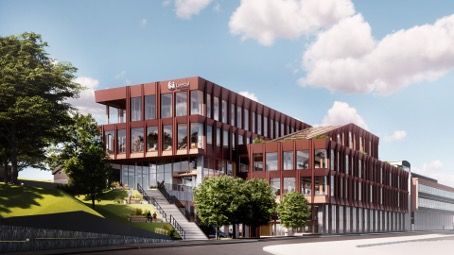
Press release -
Laerdal Cuts Energy Use by 35% with New Factory – Now Switching from Gas to District Heating
Last year, Laerdal moved all its production in Stavanger to a new factory at Forus. The remaining buildings are now being converted into a new headquarters. Already, energy consumption in both the office and factory has dropped by 35%. Historically, gas has accounted for nearly half of total energy use, but now the gas is being turned off and replaced with district heating – both at the Forus factory and the Stavanger office.
“The building is already equipped for hydronic heating, so converting from natural gas to district heating can be done without major structural changes,” says Ingrid Vestvik, Director at Lyse Neo.
Switching from gas to district heating means lower emissions. But as more buildings want to connect to district heating, Lyse will need to dig a new heating pipeline through the city center, which will affect several roads. Buildings like K8, Bykronen, and Laerdal are among those now switching to district heating.
District heating in the Stavanger region is powered by surplus energy generated from burning non-recyclable waste. This energy is used to heat water, which is then distributed through well-insulated underground pipes to connected buildings.
“Instead of Laerdal heating its own water with natural gas, they now receive pre-heated water from Lyse – generated from your trash. The more people use district heating, the more we cut emissions and free up electricity for other uses,” Vestvik continues.
Cutting Emissions by 98.1%
Switching from gas to district heating reduces CO₂ emissions from 202 grams CO₂/kWh to just 3.8 grams CO₂/kWh. With an energy consumption of 2 GWh, this means a reduction of nearly 400 tons of CO₂. Additionally, improved efficiency could reduce energy use by 10–15%.
“It’s important for us to reduce our emissions, and we believe Lyse’s district heating is a very good alternative. The fact that it also helps relieve pressure on the power grid – which is funded through grid fees paid by people and businesses – is a bonus,” says Alf-Christian Dybdahl, CEO of Laerdal Medical.
Much of the power grid is outdated, and capacity is already maxed out in several areas. Lyse’s subsidiary Lnett is working to upgrade the grid to meet future energy needs. As a result, grid fees are expected to rise in the coming years – something district heating helps mitigate.
“It’s such a close call that Laerdal’s neighboring building, Bykronen, was able to install significantly more EV chargers when they chose district heating instead of relying solely on electricity,” says Vestvik from Lyse.
Major Roadwork Ahead: Madlaveien and Eiganesveien to Be Dug Up
The district heating expansion through the city center will impact traffic in the coming months. The work involves extensive excavation in busy, central areas like Møllegata, Eiganesveien, and Madlaveien.
This week, Bjelland began digging in both Peder Klows gate and Møllegata. The project will proceed in phases and is scheduled to be completed by summer 2026.
“We’re now entering the most extensive and challenging phases of the project. We’ll be digging in high-traffic areas, which unfortunately means detours, changes to pedestrian and bike routes, and occasional noise. We understand this affects many people’s daily lives, and we’ll provide clear information both before and during the work,” says Richard Bjerga, Project Manager at Lyse.
